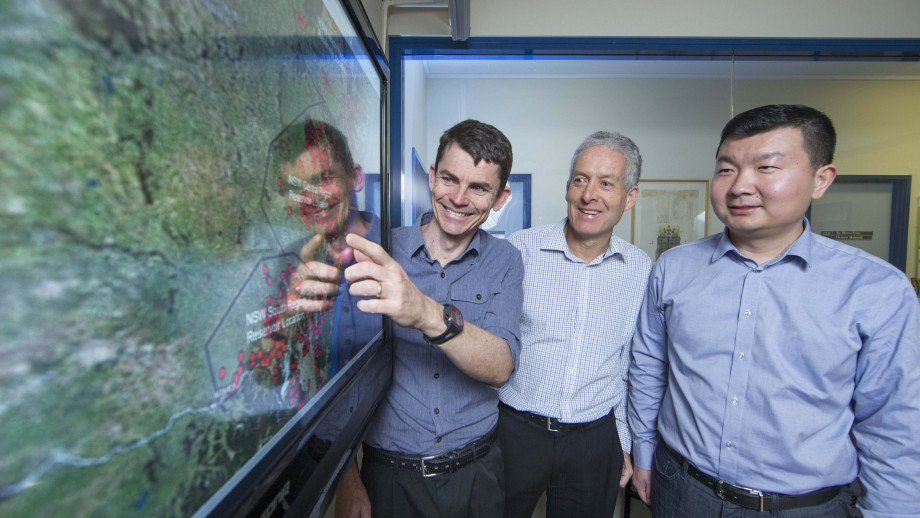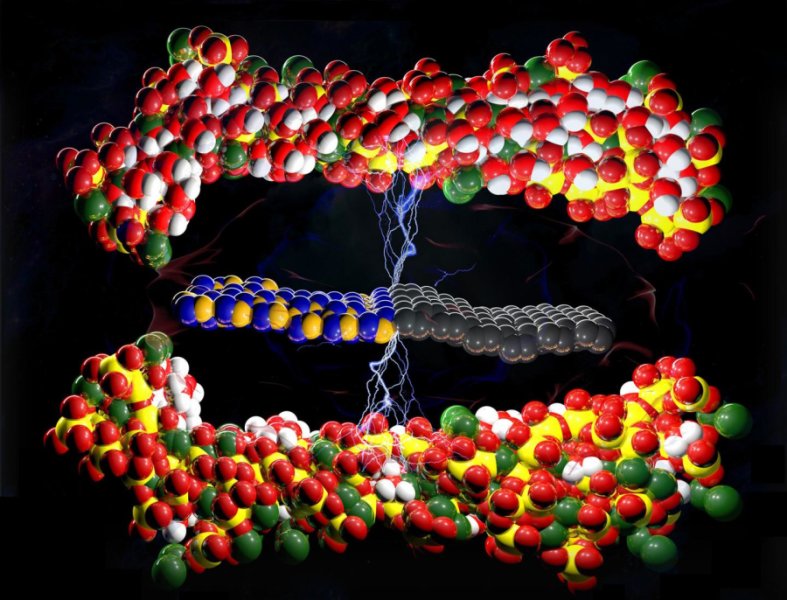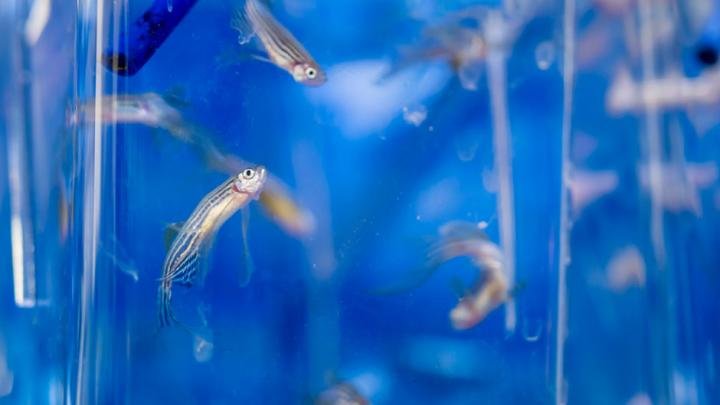See-Through Fish Aid Scientists In Autism-Related Breakthrough
February 6th, 2019
University of Miami researchers have discovered a clue in the humble zebrafish's digestive tract that, one day, could help people on the autism spectrum alleviate one of the most common yet least studied symptoms of their disorder: gastrointestinal distress.
By replicating a mutation in zebrafish that causes a rare, autism-related genetic condition known as Phelan-McDermid Syndrome in humans, the researchers found a drastic reduction in the number of cells that produce serotonin in the mutant zebrafish's gut. Perhaps better known as the body's natural mood stabiliser, serotonin also initiates the contractions that move food through the digestive system.
Published last week in the journal Molecular Autism, the study is the first to show that a mutation of a particular autism-associated gene, SHANK3, causes food to move through the digestive tract at an abnormally slow pace. While the finding applies to zebrafish, a common freshwater aquarium species that shares about 70 percent of its genes with humans, it could explain why many people with an autism spectrum disorder, and particularly those with Phelan-McDermid Syndrome (PMS), often suffer severe and disruptive bouts of constipation, diarrhoea, reflux, and/or cyclical vomiting.
More importantly, it could open the door to treatments that alleviate such unpleasant gastrointestinal, or GI, symptoms.
"The fact that we see reduced motility in the GI tract of fish with shank3 mutations is likely explained by the absence of these serotonin-producing cells, and that suggests that if we could find a way to increase motility we might be able to help with the GI problem," said senior author Julia Dallman, associate professor of biology whose UM lab studies inherited nervous system disorders by modelling them in zebrafish. "One issue in autism right now is that a lot of the drugs given to kids with autism to address their behavioural issues actually make their gut function worse. So by having a model of gut function we can try to find treatments that don't make it worse."
Dallman and two of her graduate students, David M. James and Robert A. Kozol, the first co-authors of the study, began earnestly modelling GI distress in zebrafish after they were invited to the 2016 biennial meeting of the international Phelan-McDermid Syndrome Foundation in Orlando. There they heard firsthand accounts from parents of children born with PMS which, caused by a deletion or mutation of the SHANK3 gene at the end of chromosome 22, is characterised by moderate to severe intellectual disabilities and developmental delays, absent or delayed speech, decreased muscle tone, and epileptic seizures.
Yet, despite all those very daunting challenges, parents often expressed deep frustration over their child's GI issues, which affected their quality of life on a daily basis, often making ordinary routines and milestones, like eating and toilet-training, exceedingly difficult.
"At that time, there hadn't been much published about GI issues in our community, but when you listen to parents they would always talk about how troubling it was," said Geraldine Bliss, past chair of the foundation's research support committee."There was a whole constellation of issues -- sometimes diarrhoea, sometimes constipation, sometimes alternating diarrhoea and constipation, reflux -- all kinds of GI problems, but it hadn't really been characterised or reported in the literature."
Now, the common zebrafish and James' interest in characterising GI issues in autism seem destined to help shed light on the confounding problem.
About an inch long at maturity, the zebrafish is a valuable model for human disease because, aside from having a similar genetic structure to humans, it develops rapidly and, until its second week of life, is almost completely transparent. That's when it begins developing the telltale dark stripes for which it is named.
That early transparency, coupled with an apparent zeal for what juveniles consider yummy food, enabled James and Kozol to record what happens when zebrafish lacking the shank3 gene digested chicken egg yolks, which were infused with tiny, florescent-green tracking beads. The films clearly showed that the mutant fish not only had slower and less frequent gut contractions than normal zebrafish, but that the ingested food particles got stuck in the junction between the stomach and the intestine for prolonged periods of time.
The reason came as a surprise. Initially, the researchers hypothesised the shank3 mutation somehow damaged the fish's enteric nervous system -- the "brain" that controls the gut -- but that was perfectly normal. Instead, the researchers found the shank3 mutants had drastically fewer serotonin-producing cells than their wild-type counterparts.
"It was definitely an 'Aha!' moment," James said. "It opens up a lot, in terms of studying potential mechanisms for how all this dysmotility is occurring. If we can figure that out, we can start talking about what the proper treatments are, and what's going to fix this -- that's the real question."
The answer may lie in the distant future, but this first crucial step in unraveling a biological reason for autism-related GI distress is heartening to members of the PMS foundation, which began as a family support group in 1998, when 20 of the 23 families then known to be affected by a deletion or mutation of chromosome 22 first met.
Today, nearly 200 affected families from around the world attend the foundation's meetings, the last of which was held in Texas last summer. That's when James presented UM's research on intestinal dysmotility in zebrafish, which not only won the conference's research award but gave parents like Gail Fenton hope for a better future for their children.
"Joanna's tummy troubles have been a major source of family stress for 15 years," Fenton wrote from Australia about her 36-year-old daughter. "She is often hunched over because of tummy pain. She cries, even yells, when her tummy is sore. She'll always have Phelan-McDermid Syndrome but her life, and the lives of fellow sufferers with these complex GI issues, would be so much happier without these negatives and we are so very thankful for the research that can lead to any helpful interventions."
David M. James, Robert A. Kozol, Yuji Kajiwara, Adam L. Wahl, Emily C. Storrs, Joseph D. Buxbaum, Mason Klein, Baharak Moshiree, Julia E. Dallman.
Intestinal dysmotility in a zebrafish (Danio rerio) shank3a;shank3b mutant model of autism.Molecular Autism, 2019; 10 (1) DOI:
10.1186/s13229-018-0250-4
Scientists To Create New 'Chemical Noses' To Rid The Environment Of Industrial Pollutants
February 6, 2019: Estonian Research Council
Scientists from five European countries have joined forces to develop next-generation 'chemical noses' to remove industrial pollutants from the environment. The European Commission allocated 2.9 million euros to finance the Horizon2020 FET-OPEN project INITIO that will bring together researchers from TalTech and five other universities as well as experts from an Interspectrum OÜ operating in Estonia and an Italian company in an international research project.
The supramolecular chemistry research group of the School of Science of Tallinn University of Technology has, for five years, been engaged in building new-generation receptor-molecules that would detect and send signals on pesticides and other industrial pollutants hazardous to the environment. Such smart 'electronic-nose-devices' would allow harmful toxins to be removed before their release into the environment.
The head of the supramolecular chemistry research group, Professor Riina Aav says, "Dealing with pollutants in the environment is becoming an ever-increasing problem. One relatively unknown reason for this is that many agricultural pesticides and pharmaceutical drugs that enter the environment are 'chiral', which means they exist in two non-superimposable forms (like left and right hands). This molecular quirk makes it difficult for the pollution control technologies to identify and remove many of these pollutants and this cannot be achieved by traditional methods for analysis."
'Chirality' of substances also has an impact on the environment whereto they are released. For example, one of their forms may be more toxic than the other and the chirality of the molecules may directly affect their environmental degradation. Chiral pollutants are found in pesticides, herbicides, fungicides, freon substitutes, dyes, antibiotics and many other drugs. In most cases we have no idea about their environmental impact.
The collaborating INITIO consortium will address this major issue by first engineering molecules that act as receptors -- that recognize specific pollutants -- and then integrate them with smart nanostructures to create devices that can be deployed directly in the field to detect and destroy the pollutants. These devices will essentially function as 'chemical noses' by sniffing out the specific industrial pollutants, thus facilitating their removal and destruction.
Our research group will build the receptor-molecules for these chemical noses. We will make container molecules, the 'hemicucurbiturils', which were recently developed in the project funded by Estonian Research Council. Our researchers will also build chiral molecular systems with recognition and signaling functions to flag the presence of specific pollutants, e.g. through changing colour," Professor Aav says.
The collaborative project will end in 2021 and the ultimate goal of the project is to develop a much more effective technology for cleaning the environment.
Sandra Kaabel, Robin S Stein, Maria Fomitšenko, Ivar Järving, Tomislav Friscic, Riina Aav.
Size-control by anion templating in mechanochemical synthesis of hemicucurbiturils in the solid state. Angewandte Chemie International Edition, 2019; DOI:
10.1002/anie.201813431Heavy Drinking In Teens Causes Lasting Changes In Emotional Center Of Brain
February 6th, 2019
Binge drinking in adolescence has been shown to have lasting effects on the wiring of the brain and is associated with increased risk for psychological problems and alcohol use disorder later in life.
Now, researchers at the University of Illinois at Chicago Center for Alcohol Research in Epigenetics have shown that some of these lasting changes are the result of epigenetic changes that alter the expression of a protein crucial for the formation and maintenance of neural connections in the amygdala -- the part of the brain involved in emotion, fear and anxiety. Their results, which are based on the analysis of postmortem human brain tissue, are published in the journal Translational Psychiatry.
Epigenetics refers to chemical changes to DNA, RNA or specific proteins associated with chromosomes that change the activity of genes without changing the genes themselves. Epigenetic modifications are involved in the normal development of the brain, but they can be influenced by environmental or even social factors, such as alcohol and stress. These kinds of epigenetic alterations have been linked to changes in behavior and disease.
The researchers looked at postmortem human amygdala tissue obtained from the New South Wales Brain Tissue Resource Center in Sydney, Australia. The amygdala is the part of the brain involved in emotional regulation. The specimens were from the brains of 11 individuals who started drinking heavily before the age of 21 or early-onset drinkers; 11 individuals who started drinking seriously after the age of 21, known as late-onset drinkers; and 22 individuals with no history of alcohol use disorder. The average age of death of the individuals from whom the samples were taken was 58 years old for those without alcohol use disorder; 55 years old for early-onset drinkers; and 59 for late-onset drinkers.
Amygdalae of individuals who were early-onset drinkers had about 30 percent more of a molecule called BDNF-AS, a large non-coding RNA. Usually, RNA is involved in the production of proteins from DNA, but this one is not. BDNF-AS regulates a gene that produces a protein called BDNF. This protein is a growth factor and is crucial for the normal formation and maintenance of synapses throughout the brain. When there is more BDNF-AS, there is less BDNF. The brain tissue of early-onset drinkers had 30 percent to 40 percent less BDNF compared with brain tissue from people with no history of alcohol use disorder. This reduction in BDNF was not seen in brain samples from late-onset drinkers or from people with no alcohol use disorder.
Subhash Pandey, professor of psychiatry and director of the UIC Center for Alcohol Research in Epigenetics, and corresponding author on the paper, believes that epigenetic changes to BDNF-AS are the reason BDNF is lower in the amygdalae from people who started drinking early in life. In the amygdala from people who started drinking after age 21, there were no such changes.
"BDNF is needed for normal development in the brain and for connections to form between neurons," said Pandey, who is also a senior research career scientist at Jesse Brown VA Medical Center, Chicago. "If levels are lowered due to alcohol exposure, then the brain will not develop normally, and we see that in these brain samples where there are abnormalities in another synaptic gene, Arc, possibly making abnormal connections between neurons."
Pandey and his colleagues found that the increase in BDNF-AS in the early-onset drinkers is caused by decreased methylation of BDNF-AS. Methylation is a type of epigenetic change where a molecule containing a methyl group is added to another molecule and results in a change in genetic expression. The decreased methylation of BDNF-AS is believed to be caused by early-onset drinking and appears to be a long-lasting change.
"The epigenetic changes we saw in the amygdala of early-onset drinkers can alter the normal function of the amygdala, which helps regulate our emotions, and may cause individuals to be more susceptible for things like anxiety, which we have shown in other studies, or the development and maintenance of alcohol use disorder later in life," Pandey said.
John Peyton Bohnsack, Tara Teppen, Evan J. Kyzar, Svetlana Dzitoyeva, Subhash C. Pandey.
The lncRNA BDNF-AS is an epigenetic regulator in the human amygdala in early onset alcohol use disorders. Translational Psychiatry, 2019; 9 (1) DOI:
10.1038/s41398-019-0367-zBees Can Do Basic Arithmetic
February 6, 2019: RMIT
Researchers have found bees can do basic mathematics, in a discovery that expands our understanding of the relationship between brain size and brain power.
Building on their finding that honeybees can understand the concept of zero, Australian and French researchers set out to test whether bees could perform arithmetic operations like addition and subtraction.
Solving maths problems requires a sophisticated level of cognition, involving the complex mental management of numbers, long-term rules and short term working memory.
The revelation that even the miniature brain of a honeybee can grasp basic mathematical operations has implications for the future development of Artificial Intelligence, particularly in improving rapid learning.
Led by researchers from RMIT University in Melbourne, Australia, the new study showed bees can be taught to recognise colours as symbolic representations for addition and subtraction, and that they can use this information to solve arithmetic problems.
RMIT's Associate Professor Adrian Dyer said numerical operations like addition and subtraction are complex because they require two levels of processing.
"You need to be able to hold the rules around adding and subtracting in your long-term memory, while mentally manipulating a set of given numbers in your short-term memory," Dyer said.
"On top of this, our bees also used their short-term memories to solve arithmetic problems, as they learned to recognise plus or minus as abstract concepts rather than being given visual aids.
"Our findings suggest that advanced numerical cognition may be found much more widely in nature among non-human animals than previously suspected.
"If maths doesn't require a massive brain, there might also be new ways for us to incorporate interactions of both long-term rules and working memory into designs to improve rapid AI learning of new problems."
There is considerable debate around whether animals know or can learn complex number skills.
Many species can understand the difference between quantities and use this to forage, make decisions and solve problems. But numerical cognition, such as exact number and arithmetic operations, requires a more sophisticated level of processing.
Previous studies have shown some primates, birds, babies and even spiders can add and/or subtract. The new research, published in Science Advances, adds bees to that list.
A school for bees? How the honeybees were trained
The experiment, conducted by PhD researcher Scarlett Howard in the Bio Inspired Digital Sensing-Lab (BIDS-Lab) at RMIT, involved training individual honeybees to visit a Y-shaped maze.
The bees received a reward of sugar water when they made a correct choice in the maze, and received a bitter-tasting quinine solution if the choice was incorrect.
Honeybees will go back to a place if the location provides a good source of food, so the bees returned repeatedly to the experimental set-up to collect nutrition and continue learning.
When a bee flew into the entrance of the maze they would see a set of elements, between 1 to 5 shapes.
The shapes were either blue, which meant the bee had to add, or yellow, which meant the bee had to subtract.
After viewing the initial number, the bee would fly through a hole into a decision chamber where it could choose to fly to the left or right side of the maze.
One side had an incorrect solution to the problem and the other side had the correct solution of either plus or minus one. The correct answer was changed randomly throughout the experiment to avoid bees learning to visit just one side of the maze.
At the beginning of the experiment, bees made random choices until they could work out how to solve the problem. Eventually, over 100 learning trials that took 4 to 7 hours, bees learned that blue meant +1, while yellow meant -1. The bees could then apply the rules to new numbers.
Scarlett Howard said the ability to do basic maths has been vital in the flourishing of human societies historically, with evidence that the Egyptians and Babylonians used arithmetic around 2000BC.
"These days, we learn as children that a plus symbol means you need to add two or more quantities, while a minus symbol means you subtract," she said.
"Our findings show that the complex understanding of maths symbols as a language is something that many brains can probably achieve, and helps explain how many human cultures independently developed numeracy skills."
Scarlett R. Howard, Aurore Avarguès-Weber, Jair E. Garcia, Andrew D. Greentree, Adrian G. Dyer.
Numerical cognition in honeybees enables addition and subtraction. Science Advances, 2019; 5 (2): eaav0961 DOI:
10.1126/sciadv.aav0961More Than 100 New Gut Bacteria Discovered In Human Microbiome
February 5th, 2019
Scientists working on the gut microbiome have discovered and isolated more than 100 completely new species of bacteria from healthy people's intestines. The study from the Wellcome Sanger Institute, Hudson Institute of Medical Research, Australia, and EMBL's European Bioinformatics Institute, has created the most comprehensive collection of human intestinal bacteria to date. This will help researchers worldwide to investigate how our microbiome keeps us healthy, and its role in disease.
Reported today (4th February) in Nature Biotechnology, the new resource will allow scientists to detect which bacteria are present in the human gut, more accurately and faster than ever before. This will also provide the foundation to develop new ways of treating diseases such as gastrointestinal disorders, infections and immune conditions.
About 2 per cent of a person's body weight is due to bacteria and the intestinal microbiome is a major bacterial site and an essential contributor to human health. Imbalances in our gut microbiome can contribute to diseases and complex conditions such as Inflammatory Bowel Disease, Irritable Bowel Syndrome allergies and obesity. However, as many species of gut bacteria are extremely difficult to grow in the laboratory, there is a huge gap in our knowledge of them.
In this study, researchers studied faecal samples from 20 people from the UK and Canada, and successfully grew and DNA sequenced 737 individual bacterial strains from these. Analysis of these isolates revealed 273 separate bacterial species, including 173 that had never previously been sequenced. Of these, 105 species had never even been isolated before.
Dr Samuel Forster, first author on the paper from the Wellcome Sanger Institute and Hudson Institute of Medical Research, Australia, said: "This study has led to the creation of the largest and most comprehensive public database of human health-associated intestinal bacteria. The gut microbiome plays a major in health and disease. This important resource will fundamentally change the way researchers study the microbiome."
Standard methods to understand how the gut microbiome impacts on human health involves sequencing the DNA from mixed samples of gut bacteria to try to understand each component. However, these studies have been severely hampered by the lack of individually isolated bacteria and reference genomes from them.
The new culture collection and reference genomes will make it much cheaper and easier for researchers to determine which bacteria are present within communities of people and research their role in disease.
Dr Rob Finn, an author from EMBL's European Bioinformatics Institute, said: "For researchers trying to find out which species of bacteria are present in a person's microbiome, the database of reference genomes from pure isolates of gut bacteria is crucial. Then if they want to test a hypothesis, for example that a particular species is enriched in a certain disease, they can get the isolate itself from the collection and physically test in the laboratory if this species seems to be important."
Dr Trevor Lawley, Senior author from the Wellcome Sanger Institute, said: "This culture collection of individual bacteria will be a game-changer for basic and translational microbiome research. By culturing the unculturable, we have created a resource that will make microbiome analysis faster, cheaper and more accurate and will allow further study of their biology and functions. Ultimately, this will lead us towards developing new diagnostics and treatments for diseases such as gastrointestinal disorders, infections and immune conditions."
Samuel C. Forster, Nitin Kumar, Blessing O. Anonye, Alexandre Almeida, Elisa Viciani, Mark D. Stares, Matthew Dunn, Tapoka T. Mkandawire, Ana Zhu, Yan Shao, Lindsay J. Pike, Thomas Louie, Hilary P. Browne, Alex L. Mitchell, B. Anne Neville, Robert D. Finn, Trevor D. Lawley.
A human gut bacterial genome and culture collection for improved metagenomic analyses. Nature Biotechnology, 2019; 37 (2): 186 DOI:
10.1038/s41587-018-0009-7





